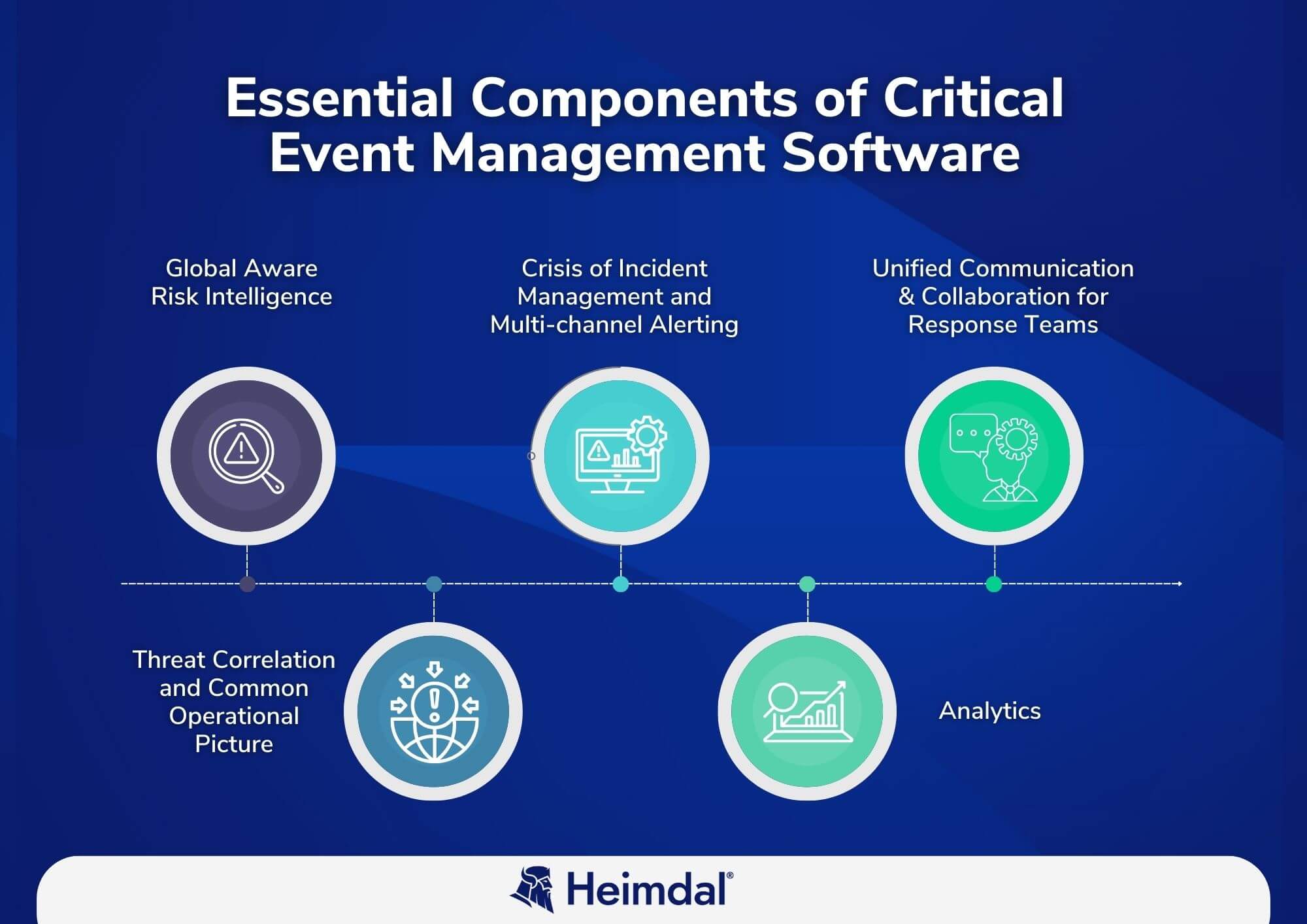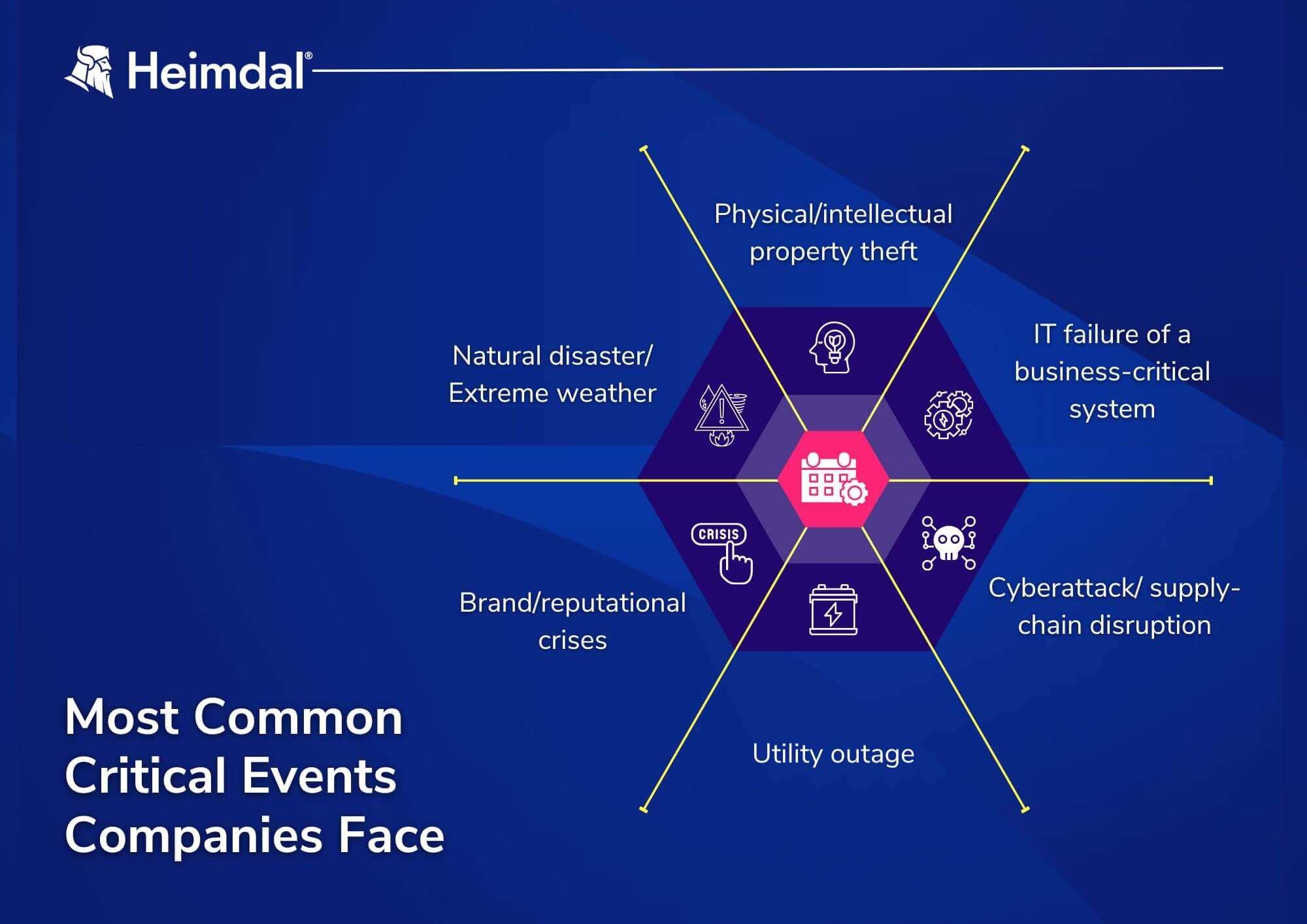Contents:
When your organization is facing a critical incident, having an effective way to manage it is essential for both managerial and financial outcomes. That’s why understanding how Critical Event Management works and how it can help you keep your organization operating as efficiently as possible is so important. In this article, we’ll discuss what Critical Event Management is and how it can help your organization prepare for and respond to critical incidents.
What Is Critical Event Management (CEM)?
Critical Event Management (CEM) refers to the process of identifying, responding to, and mitigating critical incidents that can impact an organization’s operations and reputation. It involves the development of plans, procedures, and systems to minimize the negative impact of these events and ensure a rapid, effective, and coordinated response to minimize the risk of harm, minimize downtime and protect the organization’s reputation. The goal of CEM is to ensure that the organization is prepared to handle any critical event in a timely and effective manner.
How Does CEM Work?
Critical Event Management (CEM) typically works through a series of steps:
- Preparation: The organization assesses its potential critical events, identifies critical assets and systems, and develops plans and procedures to respond to these events.
- Detection: Systems and processes are put in place to detect and alert personnel of potentially critical events.
- Assessment: The impact and severity of the event are assessed, and relevant stakeholders are notified.
- Response: The organization activates its response plan, and personnel takes appropriate action to mitigate the impact of the event.
- Mitigation: Strategies are implemented to minimize the damage caused by the event and prevent its recurrence.
- Recovery: The organization returns to normal operations, and a post-incident review is conducted to identify areas for improvement.
CEM requires the involvement of multiple departments and requires regular training, testing, and updating of plans and procedures to ensure its effectiveness. The ultimate goal of CEM is to ensure that the organization can respond quickly and effectively to critical events to minimize harm, downtime, and reputational damage.

Who Is A Candidate for Critical Event Management?
Any business, large or small, that wants to coordinate operational management tasks like security management and planning, disaster recovery and business continuity IT operations, service delivery management, and crisis communications throughout the entire organization in order to develop an integrated, cross-functional, all-hazards response, should use a CEM platform. SMBs, major corporations, healthcare facilities, educational institutions, hospitals, and governmental entities are a few examples.
Benefits of Critical Event Management for Your Organization
There are many benefits of critical event management for organizations. By managing critical events, organizations can improve communication and coordination among employees, vendors, and other stakeholders. Additionally, critical event management can help to improve organizational resilience and reduce the impact of disruptions.
Some specific benefits of utilizing critical event management within your organization include:
Improved Communication
Critical event management can help to improve communication both internally within your organization, as well as with external stakeholders such as vendors and customers. By establishing clear protocols and lines of communication before an event occurs, you can ensure that everyone is aware of their roles and responsibilities in the event of an incident. This can help to avoid confusion and chaos during a crisis situation.
Improved Coordination
In addition to improved communication, critical event management can also help to improve coordination among employees, vendors, and other stakeholders. By having a clear plan in place beforehand, everyone will know what needs to be done in the event of an incident. This can help to avoid duplication of effort and confusion about who is responsible for what tasks. A SIEM tool will allow security teams to quickly synchronize and respond to threats by providing case management, collaboration, and knowledge sharing.
Improved Resilience
One of the most important benefits of CEM is improved organizational resilience. By being prepared for potential disruptions, you can minimize the impact that they have on your business. Additionally, having a plan in place ahead of time can help you to more quickly recover from an incident and get back to business as usual.
Reduced Impact
As mentioned above, another benefit is the ability to reduce the impact of an incident. With a plan in place, you can identify potential risks and take steps to mitigate them before they become a problem. This can help to reduce any negative effects on your organization and its customers.
Overall, there are many benefits to utilizing critical event management within your organization. By improving communication and coordination, increasing resilience, and reducing the impact of incidents, you can ensure that your company is well-prepared for any emergencies or disruptions it might encounter.
Developing A CEM Plan
Making a CEM plan may appear straightforward, but for it to be successful, the plan needs to be thorough. Starting with a broad strategy, it really is expanded to address numerous crisis types with varying scopes and is mapped to suitable resources and response actions. The Business Continuity Institute’s most recent study indicates that 86% of firms have emergency plans. The most frequently triggered strategies from that same study report are highlighted in the graph below.

In light of the potential risks they may face, organizations should:
- Properly classify important events by kind, predictability, cause, and extent while distinguishing between normal emergencies and crisis events.
- Decide who will take the lead and how the company will handle each situation.
The severity levels in the plan should specify the makeup of the appropriate reaction teams so that it can be triggered as soon as possible.
If the organization has crisis management plans in place, make sure they are predictable and operational in nature. For instance, if the company runs in a hurricane-prone area, create a storm plan that addresses how to handle office closures. Make sure the plans are standardized if the company has numerous sites where it runs. Having digital plans that are easily available on a mobile device is essential in today’s mobile world when responding to important events when out of the office.
Main Challenges
Critical event management can help organizations effectively respond to and recover from disruptive incidents, but only if it is properly implemented. One of the biggest challenges faced when implementing CEM is determining which events should be considered critical. This can be a difficult task because every organization is different and has different needs.
Another challenge faced when implementing CEM is getting buy-in from all members of the organization. In order for CEM to be effective, everyone needs to be on board with the plan and committed to following it. This can be difficult to achieve, but it is essential for the success of the program.
Finally, once CEM is up and running, another challenge that organizations face is maintaining it over time. It is important to periodically review and update the critical event management plan to make sure it is still relevant and effective. Additionally, all members of the organization need to stay trained on the plan so that they are prepared to respond in the event of a critical incident.
What Critical Event Management Features Should You Consider?
There are many features of Critical Event Management (CEM) to consider when choosing a platform for your organization. Here are some key features to look for:
- Crisis and critical issue management: Dashboards that summarize the situation, impact, response, measures, media, and talking points are used to collect and communicate information about any issue or crisis. Dashboards and reports give you visibility into the status of critical events and help you track trends over time.
- Secured, integrated chat: Teams may swiftly cooperate on any issue or crisis with the help of encrypted chat features.
- Update logs: In order to keep teams updated all through the critical event lifecycle, post updates on every problem or incident.
- Action tracking: Add issue actions quickly and effectively using a basic checklist, or allocate each action and provide more information.
- Trend and impact metrics: Impact and trend markers are used to track existing and possible effects and quickly determine if things are getting better or worse.
- Calculate the duration and resolution: To clearly track how long each issue has been open for and how soon it will be addressed, use duration and resolution timings.
- BCP and crisis connections: Handle crisis responders, partners in business operations, and other relationships all in one location.
- Plans for crisis management: Choose swiftly from a number of crisis management strategy templates that have already been created, or upload and implement your own unique programs.
- Template repository: Choose from a collection of pre-built, editable crisis response plans templates and implement them promptly when necessary.
- Reputation oversight: Keep an eye on the dialogue surrounding your brand and the reputational effects of a pressing problem or crisis. Monitor the quantity, tone, and interaction with your social media posts, as well as your crisis timeline, responses, and updates.
- Security recognition: Hosting in data centers that are SOC2 and ISO27001 certified. Data sovereignty is guaranteed within the United States, Australia, and Europe, and all data is encrypted in transit using TLS v1.2.
- Real-time monitoring: A CEM platform should provide real-time monitoring of critical events so you can quickly identify and respond to issues.
- Alerts and notifications: The platform should offer configurable alerts and notifications so you can be notified of critical events as they happen.
- Root cause analysis: Root cause analysis tools help you identify the underlying causes of critical events so you can prevent them from happening in the future.
- Workflow management: Workflow management tools help you streamline the response to critical events by assigning tasks and tracking progress.
Choosing a CEM platform is a crucial decision for any organization. Make sure to consider all of the available features before making your final choice.
Best Practices for Implementing Critical Event Management
When it comes to critical event management, there are best practices that organizations should follow to ensure a successful implementation. Here are some to keep in mind:
1. Define what constitutes a critical event.
This may seem like a no-brainer, but it’s important to have a clear understanding of what your organization considers to be a critical event. This will help ensure that everyone is on the same page and that the right people and resources are brought in when a critical event does occur.
2. Have a dedicated team in place.
When a critical event occurs, you need to have a dedicated team in place who can respond quickly and effectively. This team should be trained on how to handle critical events and should have all the necessary resources at their disposal.
3. Establish clear communication protocols.
Establishing clear communication protocols ahead of time is crucial for effective critical event management. Everyone involved with the response should know who to contact and how they will be updated on the situation as it unfolds.
4. Practice, practice, practice.
Just like with anything else, practice makes perfect when it comes to critical event management. Hold regular drills and exercises so that everyone knows what to do and expects during a real-life event.
Wrapping Up…
Critical event management can be a powerful tool for any organization looking to protect its infrastructure, staff, and customers. By leveraging the latest methods in data analysis, threat detection, and risk mitigation, businesses can respond quickly and effectively when critical events occur. It is also an important tool for increasing efficiency as it enables companies to better plan for future potential threats. With this understanding of what CEM involves and how it can help your organization’s security posture, you now have the information needed to make informed decisions about whether this strategy makes sense for your business.
If you liked this article, follow us on LinkedIn, Twitter, Facebook, and YouTube for more cybersecurity news and topics.


 Network Security
Network Security
 Vulnerability Management
Vulnerability Management
 Privileged Access Management
Privileged Access Management
 Endpoint Security
Endpoint Security
 Threat Hunting
Threat Hunting
 Unified Endpoint Management
Unified Endpoint Management
 Email & Collaboration Security
Email & Collaboration Security










